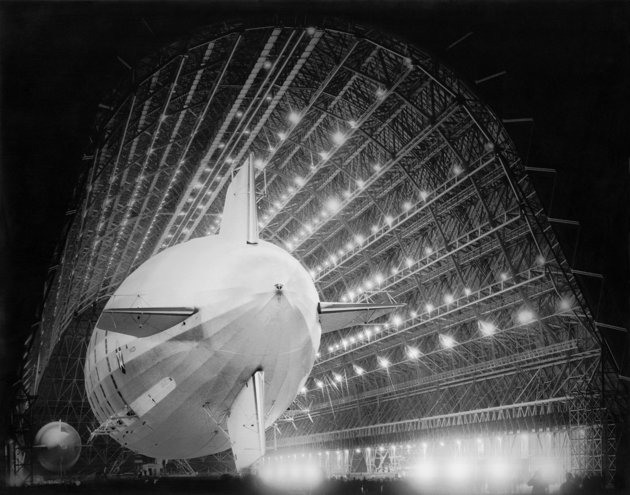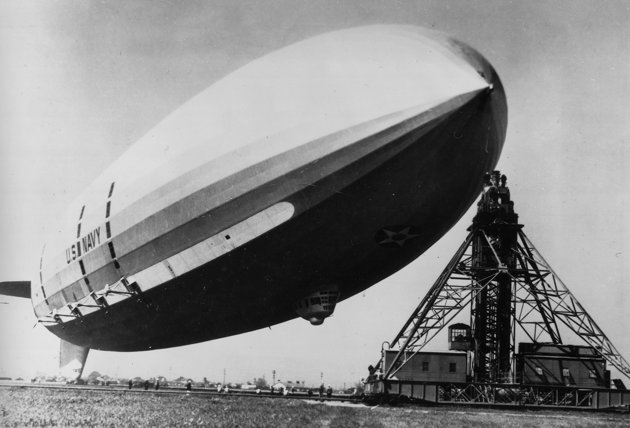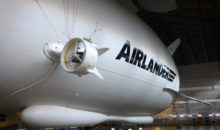On This Day: USS Macon plunges into the sea
The world’s biggest helium airship plunged into the sea during a storm on this day in 1935 – and incredibly 74 of its 76 crew survived.
The USS Macon, operated by the U.S. Navy, first lost control off California’s Big Sur coast after violent winds ripped off its already damaged tailfin.
Then, when helium also began leaking after fractured parts of its frame punctured gas cells, Lieutenant Commander Herbert Wiley ordered ballast to be dropped. But too much weight was released and the airship began to quickly rise, forcing the crew to deliberately vent more helium to stop it rising above its pressure level.
The Macon, a floating aircraft carrier, which could bear up to five biplanes, descended slowly and plunged into Monterey Bay. The crew rushed to escape and remarkably only two men died – making it one of the few airship tragedies without massive loss of life.
Radioman 1st Class Ernest Dailey was killed after jumping ship while still too high above the ocean surface to survive the fall. And Mess Attendant 1st Class Florentino Edquiba drowned while swimming back to the wreckage to try to fetch some of his belongings. An officer also nearly drowned – but was rescued by Commander Wiley, who swam to his aid and was later decorated for the deed.
A British Pathé newsreel shows the survivors arriving at San Francisco after being picked up by a U.S. Navy frigate. Along with the warm Pacific water, the men able to survive thanks to the newly issued life jackets and inflatable rafts. They were handed them after the Macon’s “sister ship” USS Akron sank in the stormy Atlantic off New Jersey’s coast and killed 73 of the 76 crew in April 1933.
Both airships, which were each 784ft long, had endured a series of almost-fatal accidents before sinking on opposite sided the American continent.
Shortly before plunging into the sea, the Macon had parts of its frame fracture and damaged its tailfin as it travelled from the east coast to the west. It also had to dump 9,000lb of ballast and 7,000lb of fuel after flying over mountains in Arizona meant it had to fly 3,000ft above its maximum pressure level. And the two major disasters – each within two years of the vessels being commission – meant the Macon was the last rigid airship built for the U.S. Navy.
Germany, which had pioneered this travel revolution, continued to fly civil airships, however during an era when fix-wing aircraft were still in their infancy. Its Graf Zeppelin completed the first passenger flight across the Atlantic in 1928 – earning the crew ticker-tape parade down New York’s Canyon of Heroes. But increasing safety fears, combined with the Great Depression damaging the global luxury travel market, hit the airship industry hard.
However, it was the fate of the hydrogen-filled Hindenburg, the world’s largest airship of any kind, that irrevocably shattered public faith in hydrogen-filled airships. A total of 35 people died after the flammable gas exploded just as the Hindenburg landed at Lakehurst, New Jersey following a flight from Berlin.

The USS Macon in Hangar One at Moffett Field, California
In the aftermath, German operators tried to substitute cheap hydrogen with expensive helium, which was inflammable. But the U.S. controlled global production of the gas and, despite now only having a few limited military blimps, refused to grant an export licence. Also, the design of fixed-wing aeroplanes had become so technologically advanced by then that they had effectively become obsolete.
The U.S. and other naval powers concentrated on building ships that would serve as aircraft carriers.
via – Yahoo.






